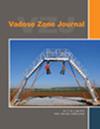耦合无创成像和反应性转运模型研究根区的水和氧动力学
IF 2.8
3区 地球科学
Q3 ENVIRONMENTAL SCIENCES
引用次数: 0
摘要
土壤中的氧气(O2)有效性对植物生长和生产力至关重要。O2在根区的迁移和消耗与土壤含水量、根的空间分布以及周围土壤的结构和异质性密切相关。在本研究中,我们通过非侵入性成像测量了玉米(Zea mays)根系的三维结构以及根区土壤水分(θ)和O2浓度的时空动态,然后基于实验数据构建了反应迁移模型并将其参数化。三种非侵入性成像方法的结合允许在高空间和时间分辨率下将模拟结果与观测结果进行直接比较。在三种不同的建模场景中,我们研究了模型中不同概念复杂性水平的结果如何能够匹配测量的θ和O2浓度模式。我们发现,考虑到非均质土壤结构和水力参数(渗透率、孔隙度和van Genuchtenα和n)的空间变异性的建模场景,相对于具有均质土壤域的简单模型,更好地再现了测量的θ和O2模式。我们组合成像和建模分析的结果表明,实验O2和水动力学可以在反应传输模型中定量再现,并且当特定系统特有的条件超出根的分布时,如土壤结构及其对水饱和度的影响和宏观气体输送途径。本文章由计算机程序翻译,如有差异,请以英文原文为准。
Coupling non‐invasive imaging and reactive transport modeling to investigate water and oxygen dynamics in the root zone
Oxygen (O2) availability in soils is vital for plant growth and productivity. The transport and consumption of O2 in the root zone is closely linked to soil moisture content, the spatial distribution of roots, as well as structure and heterogeneity of the surrounding soil. In this study, we measure three‐dimensional root system architecture and the spatiotemporal dynamics of soil moisture (θ) and O2 concentrations in the root zone of maize (Zea mays) via non‐invasive imaging, and then construct and parameterize a reactive transport model based on the experimental data. The combination of three non‐invasive imaging methods allowed for a direct comparison of simulation results with observations at high spatial and temporal resolution. In three different modeling scenarios, we investigated how the results obtained for different levels of conceptual complexity in the model were able to match measured θ and O2 concentration patterns. We found that the modeling scenario that considers heterogeneous soil structure and spatial variability of hydraulic parameters (permeability, porosity, and van Genuchten α and n), better reproduced the measured θ and O2 patterns relative to a simple model with a homogenous soil domain. The results from our combined imaging and modeling analysis reveal that experimental O2 and water dynamics can be reproduced quantitatively in a reactive transport model, and that O2 and water dynamics are best characterized when conditions unique to the specific system beyond the distribution of roots, such as soil structure and its effect on water saturation and macroscopic gas transport pathways, are considered.
求助全文
通过发布文献求助,成功后即可免费获取论文全文。
去求助
来源期刊

Vadose Zone Journal
环境科学-环境科学
CiteScore
5.60
自引率
7.10%
发文量
61
审稿时长
3.8 months
期刊介绍:
Vadose Zone Journal is a unique publication outlet for interdisciplinary research and assessment of the vadose zone, the portion of the Critical Zone that comprises the Earth’s critical living surface down to groundwater. It is a peer-reviewed, international journal publishing reviews, original research, and special sections across a wide range of disciplines. Vadose Zone Journal reports fundamental and applied research from disciplinary and multidisciplinary investigations, including assessment and policy analyses, of the mostly unsaturated zone between the soil surface and the groundwater table. The goal is to disseminate information to facilitate science-based decision-making and sustainable management of the vadose zone. Examples of topic areas suitable for VZJ are variably saturated fluid flow, heat and solute transport in granular and fractured media, flow processes in the capillary fringe at or near the water table, water table management, regional and global climate change impacts on the vadose zone, carbon sequestration, design and performance of waste disposal facilities, long-term stewardship of contaminated sites in the vadose zone, biogeochemical transformation processes, microbial processes in shallow and deep formations, bioremediation, and the fate and transport of radionuclides, inorganic and organic chemicals, colloids, viruses, and microorganisms. Articles in VZJ also address yet-to-be-resolved issues, such as how to quantify heterogeneity of subsurface processes and properties, and how to couple physical, chemical, and biological processes across a range of spatial scales from the molecular to the global.
 求助内容:
求助内容: 应助结果提醒方式:
应助结果提醒方式:


